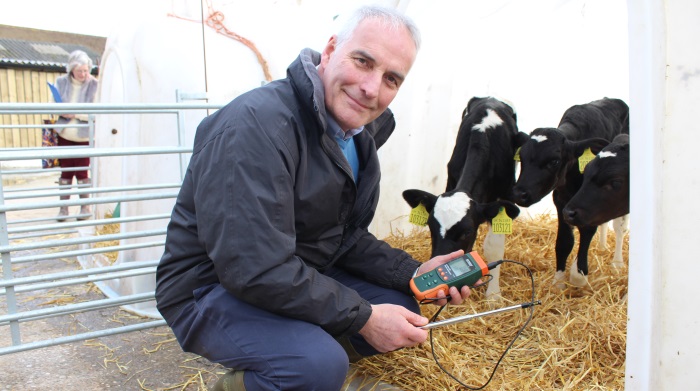Farmers are being urged to monitor the relative humidity and temperature in all calf accommodation – including hutches – throughout the year in light of farm data that suggests huge variations in both parameters, which could be compromising health and growth rates.
Data logger information collected in September and January on one of AHDB Dairy’s 13 Calf 2 Calving farms, showed that even in the winter, calf hutches saw peaks and troughs in temperature both within and between days.
At Blackmarsh Farm in Dorset, the hutches reached a day time temperature of over 45C in September, with this dropping to a 5C night time temperature within a few days. In January temperatures were as high as 24C in the day and plummeted to below 0C on the same night.
Speaking as part of the UK wide Calf 2 Calving initiative, AHDB Dairy’s technical manager David Ball said this created huge challenges for the calf.
“If temperatures fall below 15C, some of the energy from feed will need to be used by the calf to keep warm. 25C is also the calf’s upper critical limit – above this they need more energy to keep cool,” he explained.
Stress caused by cold, heat or hunger could all cause cortisol levels to rise resulting in reduced immune function, making calves more vulnerable to disease. As a result, David said it could be worth providing hutches with shade throughout the year by placing them under trees, in the shade of buildings or under a tarpaulin. Removing calf jackets on warm winter days should also be considered. Feeding rates should also be addressed in cold weather to ensure growth rates are maintained.
The farm data loggers also showed huge variations in relative humidity (RH) in the hutches, whilst RH was more stable – although still too high – in the calf shed at Blackmarsh Farm. RH is a measure of the amount of moisture in the air relative to the maximum amount of moisture that could be held by that air at that temperature and is thus a measure of its drying capacity.
David explained: “Relative humidity levels of over 70% will result in little or no pathogen desiccation (drying). A relative humidity of below 50% will inhibit pathogen growth.”
To reduce RH, ample absorptive bedding should be provided, water use in calf housing minimised and adequate ventilation and drainage provided.
David said the ultimate aim was to provide the optimum environment for the calf and urged farmers to monitor key parameters in their calf hutches and buildings. This included monitoring air flow at calf level. Ideally this should be around 0.2m/second to avoid drafts, whilst also providing sufficient flow to remove airborne pathogens. If speeds were too high, actions could include using straw bales as a shelter and covering gaps under doors.
“If we can measure parameters like relative humidity, temperature and air flow, we should be able to take action so that the environment is right for the calf, not the pathogen. This will reduce the pressure on the calf and ultimately help to reduce antimicrobial use,” he added.
He suggested the following monitoring tools:
• Put a max/min thermometer in hutches and calf buildings to check temperature throughout the year.
• Think about using data loggers to continuously monitor temperature and RH in buildings (cost from about £60).
• For one off measurements, use an anemometer to monitor air flow in calf sheds – these cost from around £7 from Amazon.
• Invest in a hygrometer to monitor relative humidity (can be bought at a garden centre).
• When monitoring parameters – take readings around the building, by doors and at calf level.
>> Calf buildings is just one of the topics being covered in a series of farm meetings run by AHDB Dairy across the country as part of the Calf 2 Calving Initiative. The aim is to bring the latest research and best practice to farmers, improve calf survival and increase the number of heifers making it into first lactation. Find out about C2C and meetings in your area at
http://www.dairy.ahdb.org.uk/c2c
The picture shows AHDB Dairy’s David Ball using an anemometer to assess temperature and air flow in calf hutches


